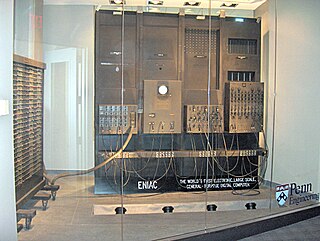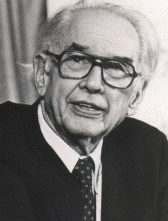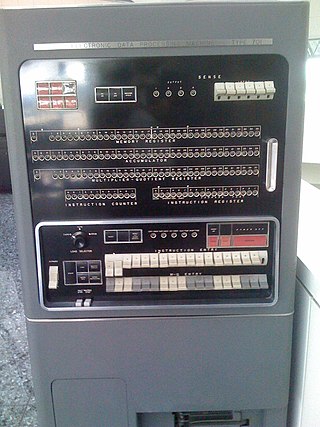
The Atanasoff–Berry computer (ABC) was the first automatic electronic digital computer. Limited by the technology of the day, and execution, the device has remained somewhat obscure. The ABC's priority is debated among historians of computer technology, because it was neither programmable, nor Turing-complete. Conventionally, the ABC would be considered the first electronic ALU – which is integrated into every modern processor's design.

ENIAC was the first programmable, electronic, general-purpose digital computer, completed in 1945. There were other computers that had combinations of these features, but the ENIAC had all of them in one computer. It was Turing-complete and able to solve "a large class of numerical problems" through reprogramming.

John Adam Presper Eckert Jr. was an American electrical engineer and computer pioneer. With John Mauchly, he designed the first general-purpose electronic digital computer (ENIAC), presented the first course in computing topics, founded the Eckert–Mauchly Computer Corporation, and designed the first commercial computer in the U.S., the UNIVAC, which incorporated Eckert's invention of the mercury delay-line memory.

The TX-0, for Transistorized Experimental computer zero, but affectionately referred to as tixo, was an early fully transistorized computer and contained a then-huge 64K of 18-bit words of magnetic-core memory. Construction of the TX-0 began in 1955 and ended in 1956. It was used continually through the 1960s at MIT. The TX-0 incorporated around 3,600 Philco high-frequency surface-barrier transistors, the first transistor suitable for high-speed computers. The TX-0 and its direct descendant, the original PDP-1, were platforms for pioneering computer research and the development of what would later be called computer "hacker" culture. For MIT, this was the first computer to provide a system console which allowed for direct interaction, as opposed to previous computers, which required the use of punched card as a primary interface for programmers debugging their programs. Members of MIT's Tech Model Railroad Club, "the very first hackers at MIT", reveled in the interactivity afforded by the console, and were recruited by Marvin Minsky to work on this and other systems used by Minsky's AI group.

John Vincent Atanasoff,, was an American physicist and inventor credited with inventing the first electronic digital computer. Atanasoff invented the first electronic digital computer in the 1930s at Iowa State College. Challenges to his claim were resolved in 1973 when the Honeywell v. Sperry Rand lawsuit ruled that Atanasoff was the inventor of the computer. His special-purpose machine has come to be called the Atanasoff–Berry Computer.
A stored-program computer is a computer that stores program instructions in electronically or optically accessible memory. This contrasts with systems that stored the program instructions with plugboards or similar mechanisms.

The IBM 701 Electronic Data Processing Machine, known as the Defense Calculator while in development, was IBM’s first commercial scientific computer and its first series production mainframe computer, which was announced to the public on May 21, 1952. It was invented and developed by Jerrier Haddad and Nathaniel Rochester based on the IAS machine at Princeton.

The Remington Rand 409, a punched card calculator which was programmed with a plugboard, was designed in 1949. It was sold in two models: the UNIVAC 60 (1952) and the UNIVAC 120 (1953). The model number referred to the number of decimal digits it could read from each punched card.

The history of computing is longer than the history of computing hardware and modern computing technology and includes the history of methods intended for pen and paper or for chalk and slate, with or without the aid of tables.
Edmund Callis Berkeley was an American computer scientist who co-founded the Association for Computing Machinery (ACM) in 1947. His 1949 book Giant Brains, or Machines That Think popularized cognitive images of early computers. He was also a social activist who worked to achieve conditions that might minimize the threat of nuclear war.

The Computer Museum was a Boston, Massachusetts, museum that opened in 1979 and operated in three locations until 1999. It was once referred to as TCM and is sometimes called the Boston Computer Museum. When the museum closed and its space became part of Boston Children's Museum next door in 2000, much of its collection was sent to the Computer History Museum in California.
Monroe Systems for Business is a provider of electric calculators, printers, and office accessories such as paper shredders to business clients. Originally known as the Monroe Calculating Machine Company, it was founded in 1912 by Jay Randolph Monroe as a maker of adding machines and calculators based on a machine designed by Frank Stephen Baldwin. It was later known as Monroe THE Calculator Company, and Monroe Division of Litton Industries.
Kyma is a visual programming language for sound design used by musicians, researchers, and sound designers. In Kyma, a user programs a multiprocessor digital signal processor (DSP) by graphically connecting modules on the display of a Macintosh or Windows computer.
Honeywell, Inc. v. Sperry Rand Corp., et al., 180 U.S.P.Q. 673, was a landmark U.S. federal court case that in October 1973 invalidated the 1964 patent for the ENIAC, the world's first general-purpose electronic digital computer. The decision held, in part, the following: 1. that the ENIAC inventors had derived the subject matter of the electronic digital computer from the Atanasoff–Berry computer (ABC), prototyped in 1939 by John Atanasoff and Clifford Berry, 2. that Atanasoff should have legal recognition as the inventor of the first electronic digital computer and 3. that the invention of the electronic digital computer ought to be placed in the public domain.

A computer is a machine that can be programmed to carry out sequences of arithmetic or logical operations (computation) automatically. Modern digital electronic computers can perform generic sets of operations known as programs. These programs enable computers to perform a wide range of tasks. The term computer system may refer to a nominally complete computer that includes the hardware, operating system, software, and peripheral equipment needed and used for full operation; or to a group of computers that are linked and function together, such as a computer network or computer cluster.
Charlie Gere is a British academic who is professor of media theory and history at The Lancaster Institute for the Contemporary Arts, The University of Lancaster and previously, director of research at the Institute for Cultural Research at The University of Lancaster. He is author of several books and articles on new media art, art and technology, continental philosophy and technology. His main research interest is in the cultural effects and meanings of technology and media, particularly in relation to post-conceptual art and philosophy.
An accounting machine, or bookkeeping machine or recording-adder, was generally a calculator and printer combination tailored for a specific commercial activity such as billing, payroll, or ledger. Accounting machines were widespread from the early 1900s to 1980s, but were rendered obsolete by the availability of low-cost computers such as the IBM PC.
This list compares various amounts of computing power in instructions per second organized by order of magnitude in FLOPS.
Information technology (IT) is a set of related fields that encompass computer systems, software, programming languages and data and information processing and storage. IT forms part of information and communications technology (ICT). An information technology system is generally an information system, a communications system, or, more specifically speaking, a computer system — including all hardware, software, and peripheral equipment — operated by a limited group of IT users, and an IT project usually refers to the commissioning and implementation of an IT system.
Samuel Lubkin (1906-1972) was a mathematician and computer scientist instrumental in the early history of computing.









